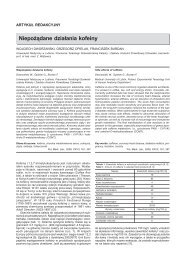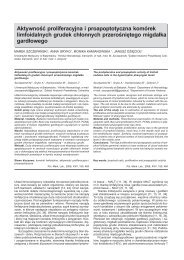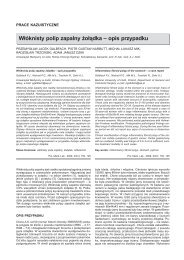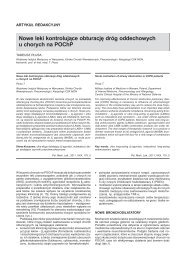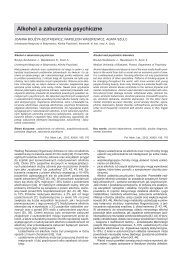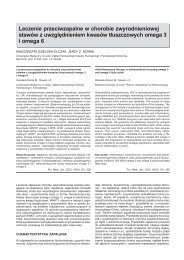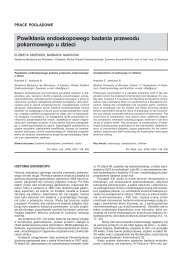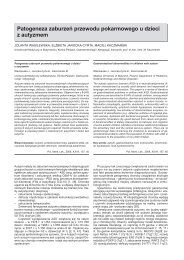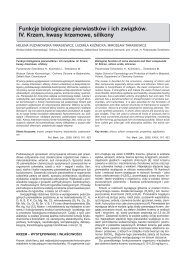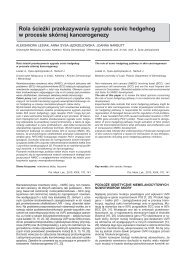Tromboelastometria – nowa metoda wspomagająca decyzje ...
Tromboelastometria – nowa metoda wspomagająca decyzje ...
Tromboelastometria – nowa metoda wspomagająca decyzje ...
You also want an ePaper? Increase the reach of your titles
YUMPU automatically turns print PDFs into web optimized ePapers that Google loves.
<strong>Tromboelastometria</strong> <strong>–</strong> <strong>nowa</strong> <strong>metoda</strong> <strong>wspomagająca</strong> <strong>decyzje</strong> terapeutyczne w zaburzeniach hemostazy… 91<br />
PODSUMOWANIE<br />
<strong>Tromboelastometria</strong> pozwala na szybką i całościową ocenę<br />
procesu krzepnięcia i fibrynolizy pełnej krwi. Interpretacja<br />
wyników polega na analizie porównawczej obrazów graficznych<br />
i danych numerycznych, przedstawiających tworzenie<br />
się skrzepu w różnym czasie i z zastosowaniem różnych odczynników.<br />
Aparatura wykorzystywana w tej metodzie jest<br />
mobilna i pozwala na wykonywanie badań przy łóżku chorego,<br />
co znacznie skraca czas diagnozowania. Umożliwia to<br />
również wielokrotne kontrolowanie stanu hemostazy pacjenta<br />
w czasie rzeczywistym. Przedstawienie graficzne dynamiki<br />
i jakości procesu krzepnięcia oraz fibrynolizy ułatwia zrozumienie<br />
zaburzeń tych układów, które mogą być spowodowane<br />
wieloma czynnikami, np.: małym stężeniem czynników<br />
krzepnięcia, małopłytkowością, utratą masywną krwi i następowymi<br />
przetoczeniami, nasiloną fibrynolizą oraz niekiedy<br />
hipotermią. Zastosowanie tej metody diagnostycznej ogranicza<br />
leczenie empiryczne i umożliwia celowaną substytucję<br />
poszczególnych składników hemostazy lub wykorzystanie<br />
leków antyfibrynylitycznych. Wynikiem takiego postępowania<br />
jest lepsze wykorzystanie zasobów krwi i preparatów<br />
krwiopochodnych. Jednocześnie możliwość wykrycia nadkrzepliwości<br />
pozwala na skuteczne jej leczenie i kontrolowanie.<br />
Wydaje się, że tromboelastometria ma szerokie zastosowanie<br />
kliniczne, jednak pełna ocena tej metody wymaga<br />
dalszych randomizowanych i obejmujących liczne grupy pacjentów<br />
badań. Przy obecnym stanie wiedzy tromboelastometrię<br />
należy traktować jako metodę diagnostyczną, która<br />
wspomaga <strong>decyzje</strong> terapeutyczne w przypadku chorych z zaburzeniami<br />
hemostazy.<br />
PIŚMIENNICTWO<br />
1. Abrahams J.M., Torchia M.B., McGarvey M. i wsp.: Perioperative assessment<br />
of coagulability in neurosurgical patients using thromboelastography.<br />
Surg. Neurol., 2002, 58, 5-12.<br />
2. Agarwal S., Senzolo M., Melikian C. i wsp.: The prevalence of a heparinlike<br />
effect shown on the thromboelastograph in patients undergoing liver<br />
transplantation. Liver Transpl., 2008, 14 (6), 855-860.<br />
3. Anderson L., Quasim I., Soutar R. i wsp.: An audit of red cell and blood<br />
product use after the institution of thromboelastometry in a cardiac intensive<br />
care unit. Transfus. Med., 2006, 16 (1), 31-39.<br />
4. Bauters A., Ducloy-Bouthors A., Lejeune C. i wsp.: Rotem® thromboelastometry<br />
in obstetric: Near patient-test as an early predictor of post-partum<br />
hemorrhage (PPH). J. Thromb. Haemost., 2007, 5, supl. 2, PS-220.<br />
5. Cammerer U., Dietrich W., Rampf T. i wsp.: The predictive value of modified<br />
computerized thromboelastography and platelet function analysis for<br />
postoperative blood loss in routine cardiac surgery. Anesth. Analg., 2003,<br />
96 (1), 51-57.<br />
6. Coacley M., Reddy K., Mackie I., Mallett S.: Transfusion triggers in orthotopic<br />
liver transplantation: a comparison of the thromboelastometry analyzer,<br />
the thromboelastogram, and conventional coagulation tests. J. Cardiothorac.<br />
Vasc. Anesth., 2006, 20 (4), 548-553.<br />
7. Davidson S.J., McGrowder D., Roughton M. i wsp.: Can ROTEM thromboelastometry<br />
predict postoperative bleeding after cardiac surgery. J. Cardioth.<br />
Vasc. Anesth., 2008, 22 (5), 655-661.<br />
8. De Gasperi A., Amici O., Mazza E.: Monitoring Intraoperative Coagulation.<br />
Transpl. Proc., 2006, 38, 815-817.<br />
9. De Pietri L., Masetti M., Montalti R. i wsp.: Use of recombinant factor IX<br />
and thromboelastography in a patient with hemophilia b undergoing liver<br />
transplantation: A case report. Transpl. Proc., 2008, 40, 2077-2079.<br />
10. Drwiła R., Ziętkiewicz M., Plitzner D.: Operacje pomostowania aortalnowieńcowego<br />
w trybie przyspieszonym u pacjentów leczonych abciksimabem.<br />
Kardiochir. Torakochir. Pol., 2006, 3 (2), 187-193.<br />
11. Findlay J.Y., Rettke S.R., Ereth M.H.: Aprotinin reduces red blood cell<br />
transfusion in orthotopic liver transplantation: a prospective, randomized,<br />
double-blind study. Liver Transpl., 2001, 7 (9), 802-807.<br />
12. Gibbs N.M., Bell R.: The effect of low-dose heparin on hypercoagulability<br />
following abdominal aortic surgery. Anaesth. Intensive Care., 1998, 26,<br />
503-508.<br />
13. Gibbs N.M., Crawford G.P., Michalopoulos N.: Thrombelastographic patterns<br />
following abdominal aortic surgery. Anaesth. Intensive Care., 1994,<br />
22, 534-538.<br />
14. Goerlinger K., Dirkmann D., Kiss G. i wsp.: ROTEM-based management<br />
for diagnosis and treatment of acute haemorrhage during liver transplantation.<br />
Euroanaesthesia, 2006, 23, supl. 1, A-322.<br />
15. Goerlinger K., Kiss G., Dirkmann D. i wsp.: ROTEM-based algorithm for<br />
management of acute haemorrhage and coagulation disorders in trauma<br />
patients. Euroanaesthesia, 2006, 23, supl. 1, A-321.<br />
16. Hartet H.: Blutgerninungstudien mit der thromboelastographic, einen neven<br />
untersuchingsver fahren. Klin. Wochenschr., 1948, 16, 257-260.<br />
17. Hartmann M., Sucker C., Boehm O. i wsp.: Effects of cardiac surgery on<br />
hemostasis. Transfus. Med. Rev., 2006, 20(3), 230-241.<br />
18. Jackson G.N.B., Ashpole K.J., Yentis S.M.: The TEG® vs. the ROTEM®<br />
thromboelastography/thromboelastometry systems. Anaesthesia, 2009,<br />
64, 212-215.<br />
19. Johansson P.I., Bochen L., Stensballe J. i wsp.: Transfusion packages<br />
for massively bleeding patients: The effect on clot formation and stability<br />
as evaluated by Thrombelastograph (TEG). Transfusion and Apheresis<br />
Science, 2008, 39, 3-8.<br />
20. Khan K.S., Wojdyla D., Say L. i wsp.: WHO analysis of causes of maternal<br />
death: a systematic review. Lancet, 2006, 367, 1066-1074.<br />
21. Lang T., Bauters A., Braun S.L. i wsp.: Multi-centre investigation on reference<br />
ranges for ROTEM thromboelastometry. Blood Coagul. Fibrinolysis.,<br />
2005, 16 (4), 301-310.<br />
22. Luddington R.J.: Thrombelastography/thromboelastometry. Clin. Lab.<br />
Haematol., 2005, 27 (2), 81-90.<br />
23. Małek Ł.A., Rużyłło W.: Krwawienie i oporność na leki <strong>–</strong> cienie współczesnego<br />
leczenia przeciwpłytkowego i przeciwkrzepliwego w kardiologii.<br />
Post. Kardiol. Interw., 2008, 4, 2 (12), 74-79.<br />
24. McNicol P.L., Liu G., Harley I.D.: Patterns of coagulopathy during liver<br />
transplantation: experience with the first 75 cases using thrombelastography.<br />
Anaesth. Intensive Care., 1994, 22 (6), 666-671.<br />
25. Nilsson C.U., Hellkvist P.D., Engström M.: Effects of recombinant human<br />
activated protein C on the coagulation system: a study with rotational<br />
thromboelastometry. Acta Anaesthesiol. Scand., 2008, 52 (9), 1246-1249.<br />
26. Pakulski C., Wudarska B.: Urazy narządów jamy brzusznej - diagnostyka<br />
i leczenie ratunkowe. Anestez. i Ratow., 2007, 3, 189-197.<br />
27. Piraccini E., Zanzani C., Caporossi E. i wsp.: Intraoperative coagulation<br />
monitoring and small bowel transplantation: a way to explore. Transplant.<br />
Proc., 2006, 38 (3), 823-825.<br />
28. Royston D., von Kier S.: Reduces haemostatic factor transfusion using<br />
héparinase-modified thrombelastography during cardiopulmonary bypass.<br />
Br. J. Anaesth., 2001, 86, 575-578.<br />
29. Rugeri L., Levrat A., David J.S.: Diagnosis of early coagulation abnormalities<br />
in trauma patients by rotation thrombelastography. J. Thromb. Haemost.,<br />
2007, 5, 289-295.<br />
30. Salhi C., Mazoyer E., Samama C.M.: Thromboelastography: one step<br />
forward. Ann. Fr. Anesth. Réanim., 2005, 24, 589-590.<br />
31. Savry C., Quinio P., Lefevre F. i wsp.: Maniability and potential interests<br />
of haemostasis monitoring by near-patient modified thromboelastometer<br />
(Rotem) in intensive care unit. Ann. Fr. Anesth. Réanim., 2005, 24,<br />
607-616.<br />
32. Sharma S.K., Philip J., Wiley J.: Thromboelastographic changes in healthy<br />
parturients and postpartum women. Anesth. Analg., 1997, 85, 94-98.<br />
33. Sharma S.K., Philip J., Whitten C.W. i wsp.: Assessment of changes in<br />
coagulation in parturients with preeclampsia using thromboelastography.<br />
Anesthesiol., 1999, 90(2), 385-390.<br />
34. Shima M., Matsumoto T., Ogiwara K.: New assays for monitoring haemophilia<br />
treatment. Haemophilia, 2008, 14, supl. 3, 83-92.<br />
35. Shore-Lesserson L.: Transfusion algorithms: More than just alphabet<br />
soup? J. Cardiothorac. Vasc. Anesth., 1997, 11, 813-814 (editorial).<br />
36. Shore-Lesserson L., Manspeizer H.E., DePerio M. i wsp.: Thromboelastographyguided<br />
transfusion algorithm reduces transfusions in complex<br />
cardiac surgery. Anesth. Analg., 1999, 88, 312-319.<br />
37. Spiess D., Gillies B.S., Chandler W.: Changes in transfusion therapy and<br />
reexploration rate after institution of a blood management program in cardiac<br />
surgical patients. J. Cardiothorac. Vasc. Anesth., 1995, 9, 168-173.<br />
38. Tuman K.J., McCarthy R.J., Djuric M. i wsp.: Evaluation of coagulation<br />
during cardiopulmonary bypass with a heparinase-modified thromboelastographic<br />
assay. J. Cardiothorac. Vasc. Anesth., 1994, 8 (2), 144-149.<br />
39. Vaidya A., Muthusamy A.S., Hadjianastassiou V.G. i wsp.: Simultaneous<br />
pancreas - kidney transplantation: to anticoagulate or not? Is that a question?<br />
Clin. Transplant., 2007, 21 (4), 554-557.<br />
40. Whitta R.K., Cox D.J., Mallett S.V.: Thrombelastography reveals two causes<br />
of haemorrhage in HELLP syndrome. Br. J. Anaesth., 1995, 74, 464-468.<br />
41. Ziętkiewicz M., Drwiła R., Wieczorek R. i wsp.: Tromboelastografia jako<br />
<strong>metoda</strong> oceny układu krzepnięcia u pacjentów po operacji kardiochirurgicznej<br />
- doświadczenia własne. Materials of the I Congress of Cardiac<br />
Surgeons of Ukraine and of Poland „Topical problems of Cardiac Surgery”,<br />
Lviv, 26-28 may 2005.<br />
Otrzymano 28 kwietnia 2009 r.<br />
Adres: Janusz Trzebicki, I Klinika Anestezjologii i Intensywnej Terapii, Warszawski<br />
Uniwersytet Medyczny, 02-502 Warszawa, ul. Lindleya 4, tel. 022<br />
502 17 21, e-mail: jtrzebicki@gmail.com




